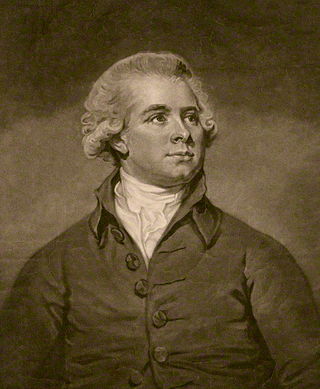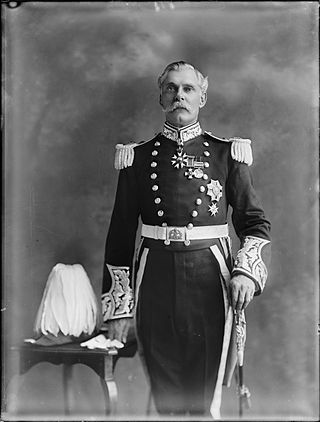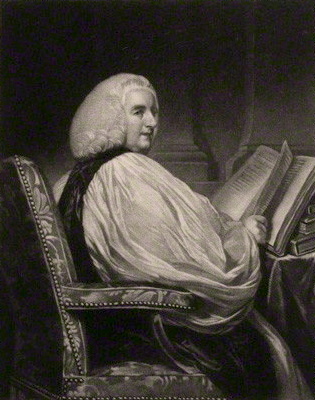
Earl Grey is a title in the peerage of the United Kingdom. It was created in 1806 for General Charles Grey, 1st Baron Grey. In 1801, he was given the title Baron Grey of Howick in the County of Northumberland, and in 1806 he was created Viscount Howick in the County of Northumberland, at the same time as he was given the earldom. A member of the prominent Grey family of Northumberland, Earl Grey was the third son of Sir Henry Grey, 1st Baronet of Howick.

Marquess of Anglesey is a title in the Peerage of the United Kingdom. It was created in 1815 for Henry Paget, 2nd Earl of Uxbridge, a hero of the Battle of Waterloo, second in command to the Duke of Wellington. The Marquess holds the subsidiary titles of Earl of Uxbridge, in the County of Middlesex, in the Peerage of Great Britain (1784), Baron Paget, de Beaudesert, in the Peerage of England (1553). He is also an Irish Baronet, of Plas Newydd in the County of Anglesey and of Mount Bagenall in the County of Louth.

Earl of Galloway is a title in the Peerage of Scotland. It was created in 1623 for Alexander Stewart, 1st Lord Garlies, with remainder to his heirs male bearing the name and arms of Stewart. He had already been created Lord Garlies in the Peerage of Scotland in 1607, with remainder to the heirs male of his body succeeding to the estates of Garlies. This branch of the Stewart family were distant relatives of the Stewart Kings of Scotland.

Earl of Malmesbury is a title in the Peerage of Great Britain. It was created in 1800 for the diplomat James Harris, 1st Baron Malmesbury. The son of the grammarian and politician James Harris, he served as Ambassador to Spain, Prussia, Russia and France and also represented Christchurch in the House of Commons. Harris had been created Baron Malmesbury, of Malmesbury in the County of Wiltshire, in 1788. He was made Viscount FitzHarris, of Hurn Court in the County of Southampton, at the same time as he was given the earldom. The earldom and viscountcy were the last creations in the peerage of Great Britain, future titles being made in the peerage of the United Kingdom which took effect three days later.

Viscount Hood, of Whitley in the County of Warwick, is a title in the Peerage of Great Britain. It was created in 1796 for the famous naval commander Admiral Samuel Hood, 1st Baron Hood. He had already been created a Baronet, of Catherington, in the Baronetage of Great Britain on 20 May 1778, and Baron Hood, of Catherington in the County of Southampton, in the Peerage of Ireland in 1782.

Earl of Stradbroke, in the County of Suffolk, is a title in the Peerage of the United Kingdom. It was created in 1821 for John Rous, 1st Baron Rous, who had earlier represented Suffolk in the House of Commons.

Baron Henniker, of Stratford-upon-Slaney in the County of Wicklow, is a title in the Peerage of Ireland. It was created in 1800 for Sir John Henniker, 2nd Baronet, who had previously represented Sudbury and Dover in the House of Commons. His son, the second Baron, also sat as a Member of Parliament. In 1792 he assumed by Royal licence the additional surname of Major. He was childless and was succeeded by his nephew, the third Baron. He assumed the additional surname of Major by Royal licence in 1822. His son, the fourth Baron, represented Suffolk East in Parliament. In 1866 he was created Baron Hartismere, of Hartismere in the County of Suffolk, in the Peerage of the United Kingdom. This title gave him and his descendants an automatic seat in the House of Lords. He was succeeded by his son, the fifth Baron. He also sat as Member of Parliament for Suffolk East and later held minor office in the Conservative administrations of Benjamin Disraeli and Lord Salisbury. His grandson, the eighth Baron, was a prominent diplomat and notably served as British Ambassador to Jordan and to Denmark. As of 2014 the titles are held by the latter's son, the ninth Baron, who succeeded in 2004.

Baron Feversham is a title that has been created twice, once in the Peerage of Great Britain and once in the Peerage of the United Kingdom. The first creation, in the Peerage of Great Britain, came in 1747 when Anthony Duncombe, who had earlier represented Salisbury and Downton in the House of Commons, was made Lord Feversham, Baron of Downton, in the County of Wilts. He had previously inherited half of the enormous fortune of his uncle Sir Charles Duncombe. However, Lord Feversham had no sons and the barony became extinct on his death in 1763. The peerage was revived in the Peerage of the United Kingdom in 1826 in favour of his kinsman Charles Duncombe, who was created Baron Feversham, of Duncombe Park in the County of York. He was a former Member of Parliament for Shaftesbury, Aldborough, Heytesbury and Newport. Duncombe was the grandson of Thomas Duncombe, son of John Brown by his wife Ursula Duncombe, aunt of the first Baron of the 1747 creation. Ursula had inherited the other half of her brother Sir Charles Duncombe's fortune. Lord Feversham son, the second Baron, sat as a Conservative Member of Parliament for Yorkshire and the North Riding of Yorkshire.

Baron Wolverton, of Wolverton in the County of Buckingham, is a title in the Peerage of the United Kingdom. It was created in 1869 for the banker George Glyn. He was the fourth son of Sir Richard Carr Glyn, 1st Baronet, of Gaunt's House, Lord Mayor of London in 1798, himself the fourth son of Sir Richard Glyn, 1st Baronet, of Ewell, Lord Mayor of London in 1758. Lord Wolverton was succeeded by the eldest of his nine sons, the second Baron. He was a Liberal politician and served under William Ewart Gladstone as Paymaster General and as Postmaster General. He was childless and was succeeded by his nephew, the third Baron. He was the eldest son of Vice-Admiral the Hon. Henry Carr Glyn, younger son of the first Baron. He died childless the following year aged only twenty-six, and was succeeded by his younger brother, the fourth Baron. He served as Vice-Chamberlain of the Household from 1902 to 1905 in the Conservative administration of Arthur Balfour. On the death in 1988 of his second but eldest surviving son, the fifth Baron, this line of the family failed. The title was inherited by the late Baron's second cousin, the sixth Baron. He was the grandson of the Hon. Pascoe Glyn, younger son of the first Baron. As of 2011 the title is held by his grandson, the eighth Baron, who succeeded in 2011.

Baron Rothschild, of Tring in the County of Hertfordshire, is a title in the Peerage of the United Kingdom. It was created in 1885 for Sir Nathan Rothschild, 2nd Baronet, a member of the Rothschild banking family. He was the first Jewish member of the House of Lords not to have previously converted to Christianity. The current holder of the title is Nathaniel Rothschild, 5th Baron Rothschild, who inherited the barony in February 2024.

Marquess of Ripon, in the County of York, was a title in the Peerage of the United Kingdom. It was created in 1871 for the Liberal politician George Robinson, 2nd Earl of Ripon.

John Poynder Dickson-Poynder, 1st Baron Islington, born John Poynder Dickson and known as Sir John Poynder Dickson-Poynder from 1884 to 1910, was a British politician. He was Governor of New Zealand between 1910 and 1912.

Hartham Park is a Georgian manor house in Wiltshire, England, about 1+1⁄4 miles (2.0 km) north of the town of Corsham. Originally designed by James Wyatt, and set today in 50 acres (20 ha), it has within its grounds a stické tennis court. The house and nearby buildings were developed as a private business park in the late 1990s, although the house retains its Georgian facade and look.

Baron Rokeby, of Armagh in the County of Armagh, was a title in the Peerage of Ireland. It was created in 1777 for The Most Rev. Dr Richard Robinson, Church of Ireland Lord Primate of All Ireland and Lord Archbishop of Armagh, with remainder to his brothers and his father's second cousin Matthew Robinson and the heirs male of their bodies. In 1785 he also succeeded his elder brother as 3rd Baronet according to a special remainder. Lord Rokeby never married and was succeeded in the barony and baronetcy according to the special remainders in the letters patent by his third cousin Matthew Robinson-Morris, the second Baron and fourth Baronet. He was the son of Matthew Robinson, son of Thomas Robinson, son of Sir Leonard Robinson, brother of William Robinson, great-grandfather of the first Robinson Baronet and the first Baron Rokeby. The second Baron was an academic, politician and eccentric. Born Matthew Robinson, he assumed by Royal licence the additional surname of Morris in 1746 on succeeding to the Mount Morris Estate in Monks Horton, Kent through his mother. He never married and was succeeded by his nephew Morris Robinson, the third Baron. He was the elder son of Morris Robinson.

Baron Tredegar, of Tredegar in the County of Monmouth, was a title in the Peerage of the United Kingdom. It was created on 16 April 1859 for the Welsh politician Sir Charles Morgan, 3rd Baronet, who had earlier represented Brecon in Parliament. His eldest son, Charles Rodney Morgan, sat as Member of Parliament for Brecon, but predeceased his father. The first baron was therefore succeeded by his next eldest son, the second baron.
There have been eight baronets surnamed Dickson holding between them two baronetcies:

Baron Selsey, of Selsey in the County of Sussex, was a title in the Peerage of Great Britain. It was created on 13 August 1794 for Sir James Peachey, 4th Baronet, Master of the Robes to King George III. He was succeeded by his son, the second Baron. He represented St Germans and Shoreham in Parliament. His eldest son, the third Baron, was a Captain in the Royal Navy. The titles became extinct on his death in 1838.

The Smithbaronetcy, of East Stoke in the County of Nottingham, is a title in the Baronetage of Great Britain. It was created on 31 October 1757 for the banker George Smith, High Sheriff of Nottinghamshire from 1757 to 1759. He was the eldest son of Abel Smith I (1686–1756) of Nottingham, the 2nd son of Thomas Smith I (1631–1699), the founder of Smith's Bank in Nottingham. His younger brothers included: Abel Smith II, and John Smith, ancestor of Julian Pauncefote, 1st Baron Pauncefote.
Admiral Sir Archibald Dickson, 1st Baronet (c.1739–1803) was a Royal Navy officer.

Earl of Arran is a title in the Peerage of Ireland. It is not to be confused with the title Earl of Arran in the Peerage of Scotland. The two titles refer to different places: the Aran Islands in Ireland, and the Isle of Arran in Scotland. The Irish earldom is held by the Gore family. The Scottish earldom is a separate title, held as a subsidiary title of the Duke of Hamilton.













